The Deal With Cuba by Cruise Ship
You may have
noticed that the Why Travel Why Not homepage has not been updated recently, or
maybe you haven’t because you don’t pay that close of attention to my
blog. Most of my lapse in posting has been
because I am going through some major life changes (getting a new job and
moving to a new city). This past week
however, I spent cruising to Cuba, touring famous cities, eating tasty food,
limping through conversations with local with my rusty Spanish, and writing
posts in my down time. In all I visited
Havana, Cienfuegos, and Santaigo de Cuba on Fathom’s Adonia. In the weeks to come (on my regular posting
schedule of Thursdays) I will post about each of these cities, but for this
post I am going to broach some of the big questions about why Americans can all
of the sudden cruise to Cuba and why. I
will also give a few of my first impressions.
Currently there is only one cruise ship that
Americans can take to Cuba, and that is the Adonia operated by Fathom. Adonia, which is a new cruise line owned by
Carnival Corporation, is Fathom’s sole cruise ship. The logo of Fathom is an outline of a person
with outstretched arms, because Fathom specializes in People to People
trips. People to people excursions are
US government endorsed and approved trips to other countries, trips that often
require special permission from the US government to occur, like the People to
People student ambassador trips which allows middle school students to travel
abroad without their parents.
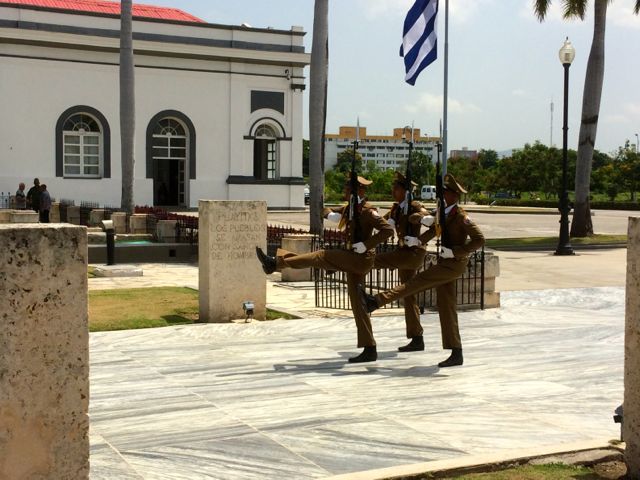 |
| Soliders march at the changing of the guard at the tomb of Jose Marti, one of Cuba's national heroes. |
In the case of
Cuba, People to People ensures that US citizens traveling to Cuba complete all
of the requirements for a “cultural exchange” with citizens of Cuba and assists
US citizens with completing all US government paperwork (including a travel
affidavit previously only used by journalists and the like to travel to Cuba)
and Cuban travel requirements (like acquiring a Cuban travel visa). Completing
the requirements of a cultural exchange in Cuba that fulfills the requirements
outlined in the travel affidavit, means that travels must engage in culturally
enriching activities for at least 8 hours a day, with records, like a journal
with times, places, and activities the traveler engaged in at least 8 hours a
day, with receipts to back it up.
Fathom fulfills
these requirements by organizing tours, shows, and meals for the passenger to
engage in at each port while on shore.
Once the required 8 hour time limit (or shorter is the ships is only in
port for a shorter time period) is filled passengers are free to use the
duration of their time in port however they please. Since we overnighted in Havana, this meant an
exceptional amount of free time in the city for those that did not book
nighttime excursions. While the free
time on shore may be the most appealing aspect of this style of cruising to
many, I must say the quality of the organized tours was exceptional, and most
of my favorite sights occurred on these tours.
I will get into more details of what we did no shore in my later posts.
One more note I
want to touch on is the pricing of these cruises. They are pretty expensive, running the
average traveler $2000-$4000
per person. Since we have a lot of
flexibility and live in Florida, we got a great last minute Florida resident
deal well below the sticker price. Even
so the price of this cruise could have bought us multiple cruises on other
lines for the same length. We also did
not book until just over a week before the cruise left. Of course much of the expense is due to the
on shore tours, meals, and other mandated US government requirements that the
cruise line needs employees to deal with.
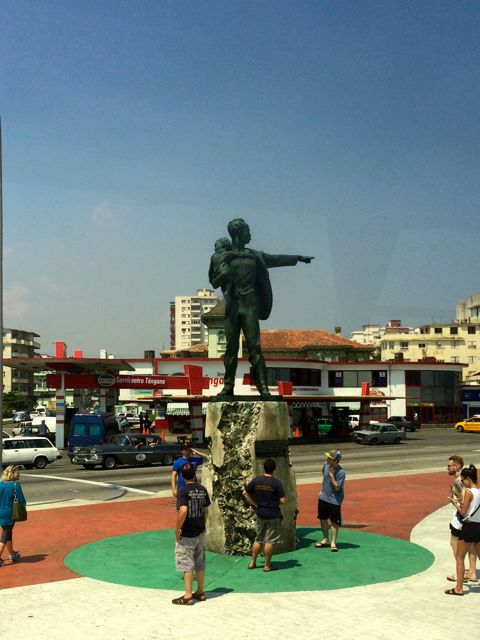 |
| This monument shows a Cuban man protecting a Cuban child from the imperialist powers. It was erected after Emilio Gonzalez was returned to Cuba from the US. |
Another
important topic about traveling to Cuba is understanding their currency. Cuba has two types of currency, the Cuban
Peso (CUP) that the Cubans use, and the Cuban Convertible Peso (CUC) that
tourists use. The CUC is matched to the
US dollar, but there is 13% in fees for converting US dollars that are not
required of Euros. So we brought some
leftover Euros from our last trip to Europe to convert and save some
money. Converting between the two
currencies 1 CUP is equal to a few cents CUC.
A common scam in Cuba are people wandering the streets approaching
tourists asking if they want to trade some foreign money for Cuban money. The scammer does not give the visitor CUC
though, but the much less valuable CUP pocketing the difference when they
convert to foreign currency later. To
help visitors out, the Cuban government puts different designs on the currency
to make them easy to differentiate.
Monuments adorn the CUCs and portraits adorn the CUPs.
The creation of
the CUC was necessary after the fall of the Soviet Union, when Cuba opened to
tourists. An influx of tourist money was
the only was to balance the loss of support from the Soviet Union. However, the creation of the CUC was the
first step towards capitalism in Cuba, which seems to slowly be gaining
momentum. Private restaurants, taxis, bed
and breakfasts all followed the creation of the CUC. Now walking around any of the ports home made
goods (mostly wooden carvings) are offered for sale to tourists, another step
towards capitalism.
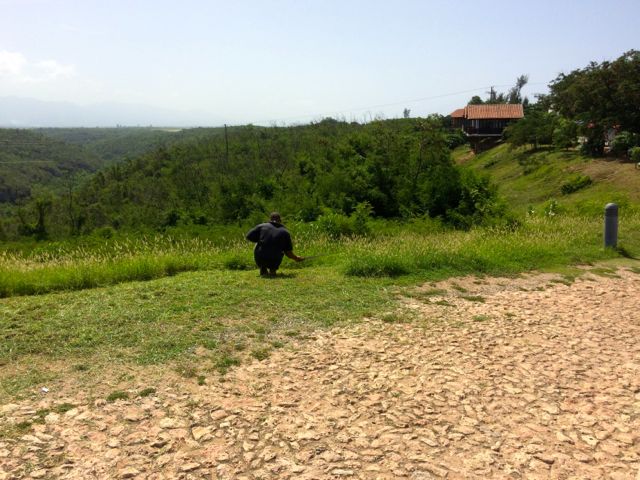 |
| I saw several of these Cuban lawnmowers near Santiago de Cuba. Men cut the tall grass with machetes. |
Aside from the
occasional Cuban trying to scam money I found the people of Cuban to be super
friendly, and wanting to engage in conversation just because they are curious
or proud of their country and want to explain why. One person in particular made us laugh with
the quote after recommending a cigar shop “I want nothing for this advice. Here in Cuba information is free.” He has an uncle in Kentucky. It seemed almost every Cuban we met had a
family member in the US, and were more than happy to tell us where they lived.
Another time
while sipping some beer on a patio after finishing with out tour group three gentlemen
sitting at the table next to us kept us busy with an hour of questions about us
and the US. They spoke almost no
English, and my just OK Spanish could not keep up with their difficult Cuban
accent (the most difficult of all Spanish accents to understand, like the
English of creoles of Louisiana). Yet
they persisted in their quest for knowledge.
They wanted to know how many Americans were visiting Cuba now, how we
got to cuba, what we did for a living, what we liked to do for fun, to dance or
cook, if we liked Cuba, how much our cruise cost, if we liked rum and
cigars. On and on they asked, while also
divulging us with information. They
showed us photos of their work, one was a boxer, and another laid tile. They played for us music videos by Cuban
artists and asked us our opinions. It
was a true people to people interaction.
Anywhere the
cruise ship came into port, hundreds of people stopped to wave and welcome
words of welcome at the ship. Taxis and
buses even stopped on the side of the road so all inside could pile out to wave
a welcome or fair well to the ship.
Of course our
English speaking Cuban tour guides were also friendly and a source of
information that my poor Spanish would have no hope of extracting. One especially we had in Havana most of the
group was so comfortable with, by the end we were asking uncomfortable
questions. Someone asked what the
divorce rate was like in Cuba, he responded by saying that newly married
couples live in one of their family’s apartments, essentially living with 3
generations of in laws. How would one
expect the divorce rate to be when a person must interact with his or her in
laws 365 days a year. Needless to say
the divorce rate is high 3 out of 5 marriages end in divorce.
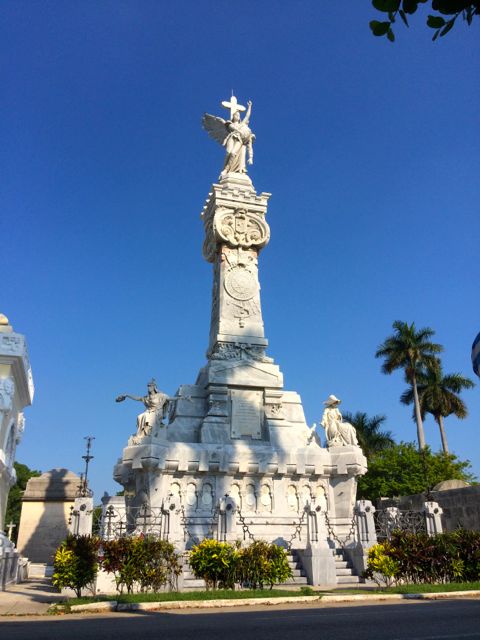 |
| This monument dedicated to fire fighters commemorates many firefighters who lost their lives and justice to a corrupt governmental system. |
Nearing the end
of our tour, I tentatively asked what the people Cuba thought of those who left
for asylum in the US, essentially abandoning their country. He answered by saying it is a choice, that he
and many Cubans do not fault them for. I
got the sense that Cuba has a lot on their hands and a person who leaves is one
less mouth to feed. Although, this is my
impression and not necessarily representative.
As a tour guide who specializes in working with Americans, he has a
special visa from the Cuban government to travel to the US and has already
visited Florida.
The last common
question to Cubans that I heard repeated over and over again by other
passengers to tour guides and locals was about the recent change in US/Cuban
relations. They asked “Now that more
Americans want to visit and invest in Cuba what do you want from more American
interaction with Cuba?” Again and again
we heard similar responses; they want us to come and visit, to invest (although
investing in Cuba is tricky since the government must maintain 51% stake in all
ventures featuring foreign investments, even if all the money to build the new
resort or restaurant or whatever comes from abroad). What they do not want is for the architecture
and culture of Cuba to change as a result of more visitation from
Americans. They don’t want their old
buildings to be demolished in favor of high rises. They want restorations of already standing
structures and the ability to buy home products to fix their homes (like a Home
Depot). Above all they do not want to
become the playground of America again.
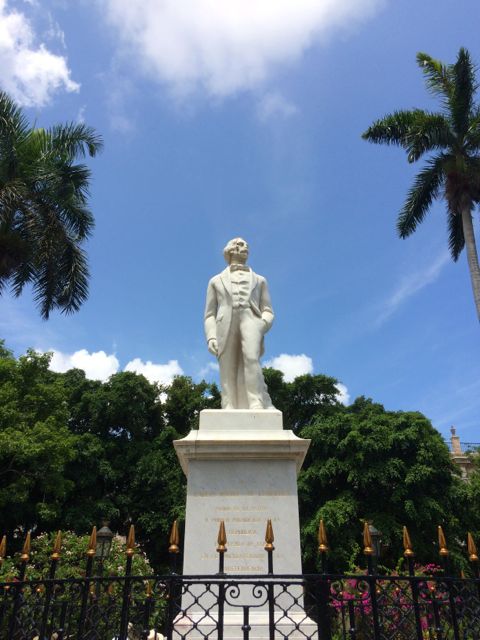 |
| This statue of the Cuban revolutionary Carlos Manuel de Cespedes resides in the Plaza de Armas in Havana. |
This adherence
to maintaining their culture and architecture has both positive and negative
results. As our guides informed us no
elevators in Cuba work despite their abundance.
An average of three buildings collapse a day in Havana from neglect and
lack of money and materials to fix them.
Currently all the money used to rejuvenate Havana comes from tourists
dollars, like tourists who eat at state restaurants or pay government employees
for a photo with traditionally dressed women.
Driving around Havana in some areas it seemed more buildings were
actively collapsing or near to it than were in usable condition. On the other hand unlike every other port in
the Caribbean there were no Senor Frogs, Starbucks, or chains of any kind. Ports in Cuba may be the most authentic in
the Caribbean. It’s impossible to tell
what will become of Cuba in the future.
I hope to go back in ten or twenty years to see how it has changed,
hopefully for the better.
This Thursday I
will be posting about my 2 days in Havana.
Until then check out my others posts by clicking one of the links on the
right hand side of the screen. All of
the places I’ve visited via cruise ship can be found by clicking on “ports” in
the lower right.
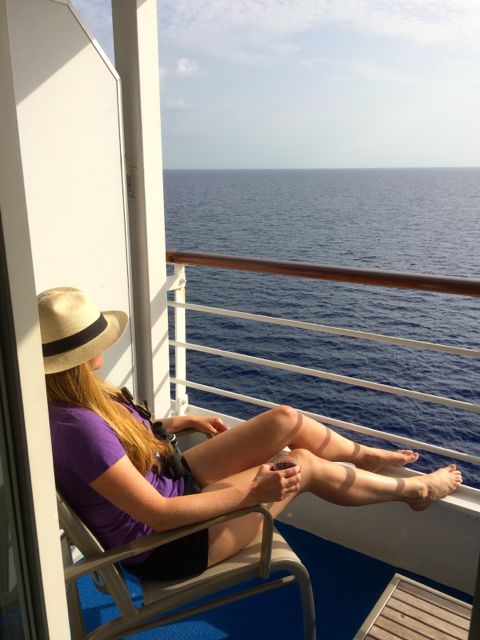
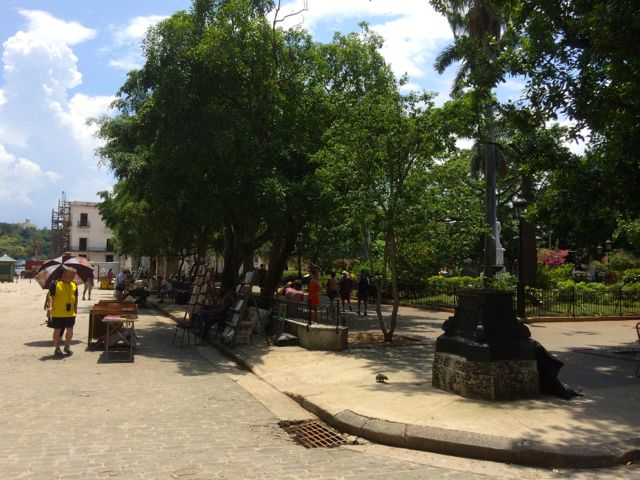

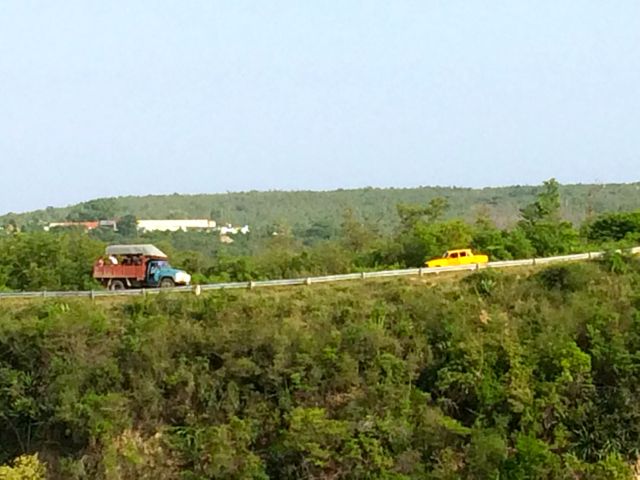
Thank you so much for your very informative blog. This will be a wonderful start for our people to people experience.
ReplyDeleteWishing you a wonderful time in California. Love, Terry